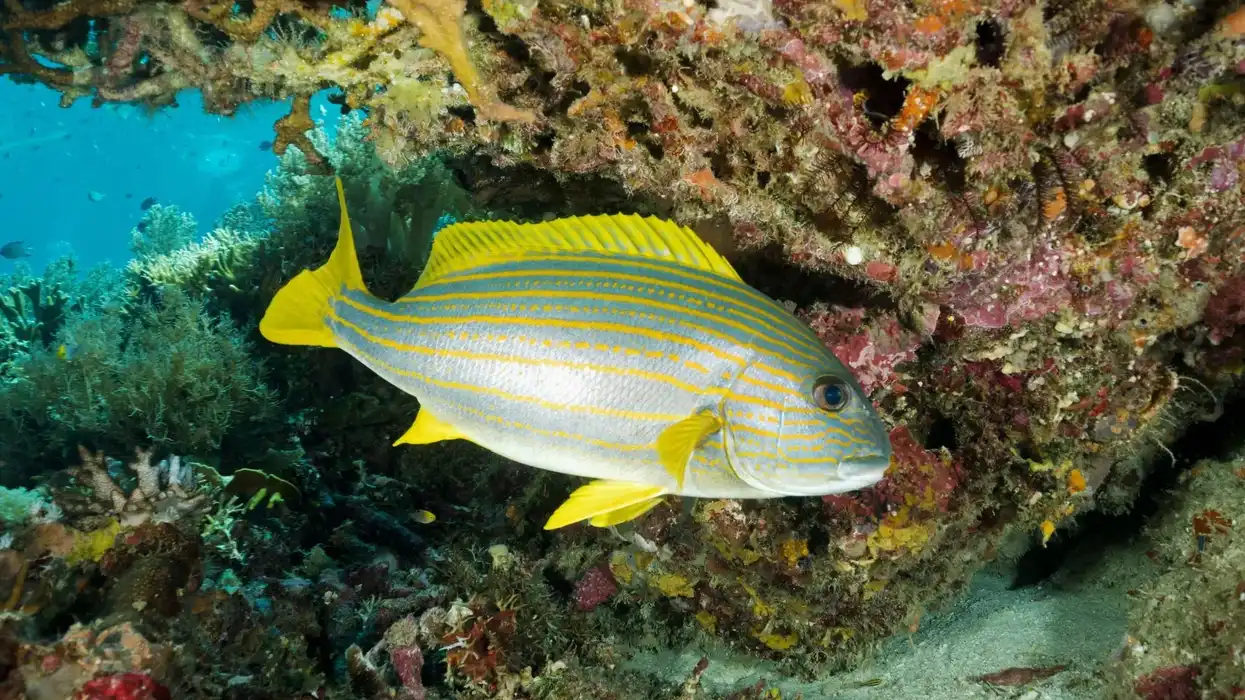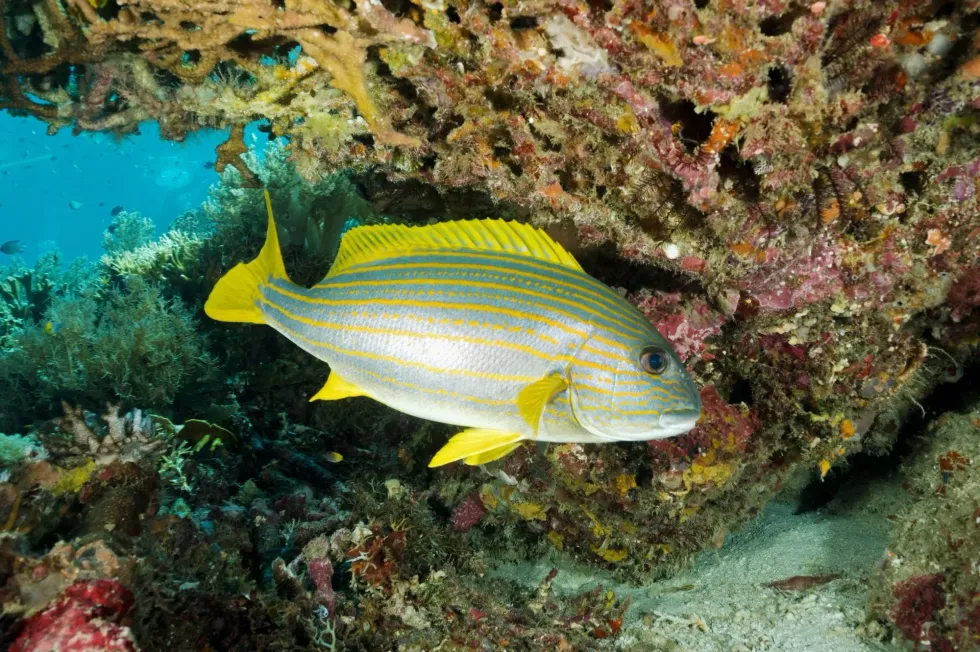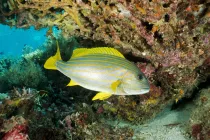The Spanish flag fish (Gonioplectrus hispanus), also known as the gold stripe sea perch or stripy snapper, is a beautiful and rare deepwater Caribbean solitary species belonging to the Serranidae family. It is the only known species in the genus Gonioplectrus.
They can be encountered in the southern islands where the coral reefs thrive. Their habitat is throughout the Atlantic Ocean in the Gulf of Mexico where the range also exceeds north to Louisiana and northwestern Cuba South. Their habitat also includes the deep shelf-edge reefs and marine water bodies.
Data explains that the distinctive color combination of the fish consisting of fluorescent pink and yellow alternate stripes resembles the Spanish flag. These fish are not suitable for community-dwelling as they are carnivores and piscivorous in nature.
They are usually found in schools of 20-30 fish. They prey on small fish, crustaceans, gastropods, and cephalopods. They are 8-12 in (20.32-30.48 cm) in length and the length of the head of the fish is almost similar to the depth of its body.
Read on to know more about the breeding, family, diet, and distribution of the fish. For more relatable content, read about black lancer catfish and black damselfish.
Spanish Flag Fish Interesting Facts
What type of animal is a Spanish flag fish?
The Spanish flag fish (Gonioplectrus hispanus) is a rare species of Caribbean deep waters marine ray-finned fish and belongs to the Serranidae family.
What class of animal does a Spanish flag fish belong to?
The Spanish flag fish (Gonioplectrus hispanus) belongs to the Actinopterygii class of the Animalia kingdom. They also belong to the Serranidae family.
How many Spanish flag fish are there in the world?
The exact number of Spanish flag fish in the world is unknown. However, they have the Least Concern status in the IUCN Red List and their population is not yet endangered hence they are widespread.
Where does a Spanish flag fish live?
These fish are found around rocky or coral reefs. The Spanish flag fish resides on deep, shelf-edge reefs, throughout the Mexican Gulf and the Atlantic Ocean.
What is a Spanish flag fish's habitat?
The Spanish flag fish resides on deep, shelf-edge reefs, throughout the Gulf of Mexico and the Atlantic Ocean. They are also extensively found over the edges of the Great Barrier Reef and over the reef flats where they sustain life.
They can be found individually or in loose schools of range of 20-30 fish, over murky waters of sheltered lagoons, turbid coastal waters, and outer coral reef slopes.
Who does Spanish flag fish live with?
Spanish flag fish live in schools of 20-30 fish. They are predatory and piscivorous in nature, and hence it is not advised to make them live with small fishes.
How long does a Spanish flag fish live?
The life expectancy of these fishes is up to 20 years.
How do they reproduce?
The Spanish flag fish, like most species of fish, reproduce through the method of spawning. The male and the female deposit their sperm and eggs respectively at the same time.
What is their conservation status?
According to the IUCN Red List of Threatened Species, the Spanish flag fish has been listed as Least Concern and their population is far from being threatened.
Spanish Flag Fish Fun Facts
What does Spanish flag fish look like?
Gonioplectrus hispanus can be recognized by a serrated preopercle which has a large spine on the ventral edge directed forward. The opercle has three spines, and the second spine is the most elongated.
The body of a Spanish flag fish is oblong with its depth being equal to the length of its head. The fish inhabits the convex nature pertaining to the dorsal part and also the infraorbital region of its head.
They have a preopercle that is well-rounded and consists of a huge spine at its angle which is also curved in nature. The lower edge of the preopercle is fleshy.
The centrally located spine is present over the gill. It reaches over the rear end of the opercular membrane. There are 13 soft rays and eight spines present at the dorsal fin.
The other fin, i.e. the anal fin, contains seven soft rays and three spines.
The spines also have bases that are fleshy and covered with scales. It's caudal fin is shorter. The scales range from 47-49 in its lateral line, which is also curved up underneath and downwards below the dorsal area and the region where the soft rays are prominent.
In addition, they also show a striking pink coloration, with seven bright yellow stripes on the sides from the head to the base of the tail or the dorsal fin which resembles the Spanish flag and hence the name of the fish.
A yellow stripe runs from the snout diagonally through the eye and upper opercle to the back of the body. There are certain yellow patches in the interorbital region and the cheek.
The pelvic fins are violet in color, and the anal fin has a crimson spot from the second anal spine as far as the first anal ray.
There is also a white, ventral blotch, which is much larger than the eye diameter. There is also a bright red-colored blotch on front of the anal fin and a white-colored blotch that is present on the side of the belly.
The pelvic fins are somewhat pinkish purple or mauve in color. This maximum length of the fish is around 8-12 in (20.32-30.48 cm) .

How cute are they?
These fish belong to the category of smaller Serranidae and are extremely attractive and adorable. They are extremely gorgeous to look at with a small and rigid body with fluorescent pink and alternate yellow stripes which run horizontally. The pelvic fins are mauve in color which enhances their beauty even more, just like yellow tang.
How do they communicate?
Data and observations show that the Spanish flag fish, like other similar fishes, communicates through motions and gestures.
How big is a Spanish flag Fish?
The maximum length of a flag fish range from about 8-12 in (20.32-30.48 cm) . Their length is smaller than cuttlefish but larger than blue rainbowfish.
How fast can a Spanish flag fish move?
The exact speed of Spanish flag fish is unknown but they are assumed to be fast swimmers pertaining to their predatory activities and to search for their prey efficiently in the marine region.
How much does a Spanish flag fish weigh?
The weight of a Spanish flag fish is between the range of 2.2-4.4 lb (1-2 kg).
What are the male and female names of the species?
There's no actual data that can distinguish the male and female members of the flag fish species. However, they have different names such as Spanish flag snapper and stripey snapper. The different names are given to this fish due to the varied range of colors and the patterns in the body.
What would you call a baby Spanish flag fish?
A baby Spanish flag fish will be called a fry.
What do they eat?
Spanish flag fish search for other fishes and sea creatures as they are carnivores in nature. They are nocturnal predators and search at night and feed mainly on smaller fish in the marine waters. They are also fond of feeding on mobile benthic crustacea like shrimps and crabs, and a vast range of gastropods and cephalopods.
Did you know...
Spanish flags are usually known to exist in pairings and can be seen swimming on the reef walls, marine overhangs, and caves as they search for food. They are often swimming in upside down or vertical directions.
They also have sharp spines present in their fins and also on the sides of their head which is related to protecting them from other predators such as larger fishes.
The Spanish flag is a deepwater Caribbean marine species that is extremely rare and extremely expensive too. Due to its vibrant and ecstatic color combination, the Spanish flag fish legal size of 12 in (30 cm) stands at a price range of $1600!
Although the fish is said to be harmful to be kept in a community tank, it can be used as a beautiful centerpiece for a fish tank consisting of similar species.
Can they be kept as a pet?
The Spanish flag fish can be chosen for an aquarium due to its small and colorfully shaped body. Its distinctive colors and exquisite looks allow it to be a promising centerpiece within a tank of its own beings and are used extensively as an ornamental fish in the aquarium trade.
The price of these fishes is extremely high as they are rare groupers of the world.
The Spanish flag fish (Gonioplectrus hispanus) is said to be an important species for recreational, artisanal, and commercial fisheries throughout its range. It is caught mostly with handlines or rod and reel and also with traps and gill nets.
It is a rare species and targeted by recreational fishers in its range. It can also be caught by trawlers. It is a commercially targeted species but the landing statistics and data are unavailable. This fish is usually sold fresh at the market.
Can you eat Spanish flag fish?
Yes, Spanish flag fish is edible and can be extremely delicious when served fresh. Spanish flag fish-eating quality is phenomenal and it is said to be a delicacy in many countries. A famous Spanish flag fish recipe is roasted Spanish flag, as well as Mediterranean fish with red sauce.
Another famous striped fish which are not only edible but also considered a delicacy is the stripey sea perch which is usually enjoyed when it is pan-fried. The striped snapper is known for its moist, firm texture that gives off a sweet sea taste. These qualities make it a fish in demand and hence the high price.
Why is it called Spanish flag Fish?
The Spanish flag fish (Gonioplectrus hispanus) is called this as they resemble the flag of Spain due to their fluorescent pink and yellow alternating stripes. Data shows that the red spot on their rear fin helps the Spanish flag fish to recognize other members of their species.
Here at Kidadl, we have carefully created lots of interesting family-friendly animal facts for everyone to discover! For more relatable content, check out these spotted ratfish and shovelnose guitarfish facts for kids.
You can even occupy yourself at home by coloring in one of our free printable Spanish flag fish coloring pages.









